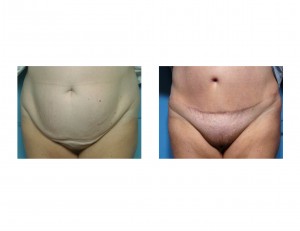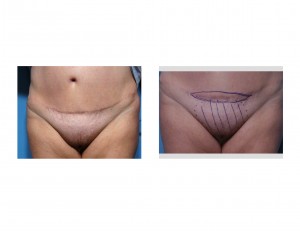Background: A tummy tuck, or abdominoplasty, is one of the best and most reliable body contouring procedures. For many women after childbirth or for men and women after extreme weight loss, a classic tummy tuck procedure can make a world of difference. But unlike the many marketing ads and images, the sheer size of the procedure and the tissues removed does not give everyone a perfect waistline or result. For some patients after surgery, and for all patients considering it, the reality is that revisional surgery or touch-ups may be desired or needed.
Case Study: This 48 year-old female was tired of her full and hanging belly. While she was not a diet or exercising fiend, she felt that she was never going to get rid of this problem. As a result, she inquired about a tummy tuck or abdominoplasty. With the amount of skin and fat that she had, and that it hung down over her pubic region, a full or complete tummy tuck was the best option. She was ore than willing to accept a long horizontal scar as a trade-off. (as well as a scar around her new belly button)

One other common tummy tuck sequelae is that the pubic hairline will be right up against the tummy tuck scar. This is unavoidable and will exist in all tummy tuck procedures. The only way to make a hair-free zone between the scar and the pubic hairline is to undergo laser hair treatments.

Case Highlights:
1) Tummy tuck surgery can make a dramatic difference in one’s waistline shape and frontal trunk contour. But it can not solve every minor detail of the abdominal problem and there are almost always residual minor issues of scar and tissue redundancies.
2) Revision of tummy tucks are not rare and can be done as early as three to six months after the original surgery depending upon the type of concern.
3P) Scar revision (scar narrowing), excision of dog ears at the sides of the tummy tuck scar, belly button adjustment, and pubic and abdominal liposuction are secondary tummy tuck options for obtaining an optimal result.
Dr. Barry Eppley
Indianapolis, Indiana


